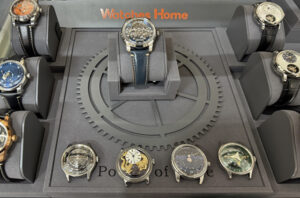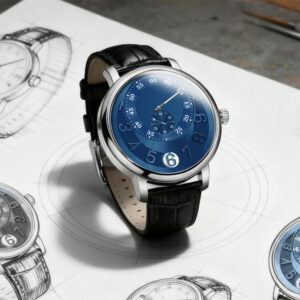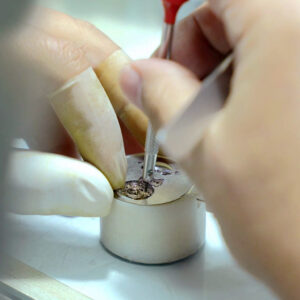Mechanical watches represent centuries of horological expertise. Behind every ticking second lies a world of engineering discipline and artistic finesse. Although most people admire the final product, only a few understand how each micro-component comes together to form a precise and reliable mechanism. This guide walks through the complete manufacturing process, showing how every step contributes to performance and longevity.
1. The Essence of Watchmaking
Mechanical watchmaking blends engineering accuracy with timeless craftsmanship. A standard wristwatch integrates more than 100 components, while an automatic calendar watch contains nearly 200. Moreover, a tourbillon, perpetual calendar, or chronograph can exceed a thousand parts working in harmony.
Most manufacturers produce the majority of components in-house. By doing so, they maintain strict control over tolerances, durability, and aesthetic quality. Only a few specialized parts—such as the mainspring, balance spring, synthetic jewels, and shock absorbers—come from external experts.
2. Raw Materials in Watch Manufacturing
The journey begins with selecting high-grade raw materials. Each material must satisfy demanding requirements for strength, finish, and dimensional consistency. For example:
-
Lead steel bars for pinions and screws
-
Lead brass bars for wheels and barrels
-
Nickel silver for balance wheels
-
High-carbon steel for escapement wheels
-
Brass and stainless steel for bridges, dials, and cases
-
Synthetic sapphire and rubber for crystals and seals
Before entering production, every material goes through rigorous inspection so manufacturers can guarantee consistency and traceability.
3. Precision Machining on Automatic Lathes
Once raw materials pass inspection, the next stage begins in the automatic-lathe workshop. Here, technicians machine around 40 categories of components with tolerances within 0.01 mm and surface roughness levels as low as Ra0.4–0.8 µm.
Automatic lathes shape pinions, balance staffs, and rotors. After machining, each part goes through heat treatment and careful polishing to improve its durability. This workflow ensures uniform quality even during large-volume production.
4. Gear Machining and Finishing
Gears form the backbone of a watch’s transmission system. The machining sequence usually includes milling, annealing, deburring, and high-precision polishing. Because gears must transfer energy smoothly, their surfaces often reach Ra0.05–0.1 µm.
Technicians inspect tooth profiles under 100× magnification. This prevents micro-defects and ensures that every wheel meshes perfectly with its counterpart, ultimately improving accuracy and reducing long-term wear.
5. Escapement and Balance Wheel Production
The escapement governs how energy flows through the movement, so accuracy depends heavily on these parts. Escapement wheels and levers come from high-quality brass or steel strips. Their dimensional errors remain under 0.01 mm, ensuring precise locking and unlocking.
Meanwhile, the balance wheel acts as the “heartbeat” of the watch. Technicians adjust each wheel for symmetry and stability, allowing it to oscillate with consistent rhythm over many years.
6. Bridge (Plywood) Processing
Bridges require exceptional precision because they support the gear train. Each bridge undergoes more than 200 machining steps, including drilling, milling, polishing, and plating.
Hole diameters often measure just 0.5 mm, with tolerances around +0.005 mm. After machining, the surface receives a nickel–diamond alloy coating to boost corrosion resistance and aesthetic appeal. Multiple aging cycles eliminate internal stress, which ensures long-term stability.
7. Watch Exterior Components: Case, Dial & Crystal
The watch exterior blends engineering with design. Stainless-steel cases go through hot extrusion, CNC machining, and multi-stage polishing until they achieve a flawless finish. Case backs are pressed and engraved with brand signatures or serial numbers.
Brass dials follow a complex routine: brushing, silver plating, stamping, laser etching, color treatment, and protective lacquering. Today, most watches use synthetic sapphire crystals, offering clarity and outstanding scratch resistance.
Finally, the case assembly goes through sealing and pressure-resistance tests to confirm water protection.
8. Physicochemical Treatments and Surface Finishing
To strengthen critical components, manufacturers rely on various physicochemical treatments. For instance:
-
Steel parts undergo heat treatment in a controlled atmosphere to prevent oxidation.
-
Copper parts go through aging cycles to remove internal stress.
-
Movement components receive nickel-diamond or gold electroplating for corrosion resistance.
-
Dials receive layers of silver, gold, or rose-gold plating to enhance brilliance.
These finishing processes keep the watch visually refined while improving durability.
9. The Assembly Process
Assembly takes place in dust-free, temperature-stable workshops kept between 18–25°C. Technicians clean and lubricate each component before fitting it. The mainspring slides into the barrel with 0.01–0.04 mm axial clearance, ensuring smooth torque output.
Next, the gear train undergoes friction and noise testing. The escapement team calibrates pallet positions and tooth engagement. Afterward, watchmakers fine-tune the balance wheel and hairspring to achieve optimal isochronism.
Because even a 0.01 mm deviation may affect performance, every step includes microscopic inspection and manual adjustment.
10. Quality Control and Testing
Quality control validates the performance of the entire watch. Technicians check raw material composition, microstructure, dimensional accuracy, and mechanical strength. The completed watch then enters a multi-day, multi-position test cycle.
Over 13 days, measurements track rate stability, amplitude, and power-reserve performance in six different positions. Only watches that meet strict standards proceed to final packing.
Conclusion
From material selection to final testing, mechanical watchmaking combines engineering, mastery, and artistic philosophy. Each stage reflects the discipline and patience that define fine horology. Ultimately, a mechanical watch becomes more than a tool—it becomes a lasting expression of heritage and precision.







